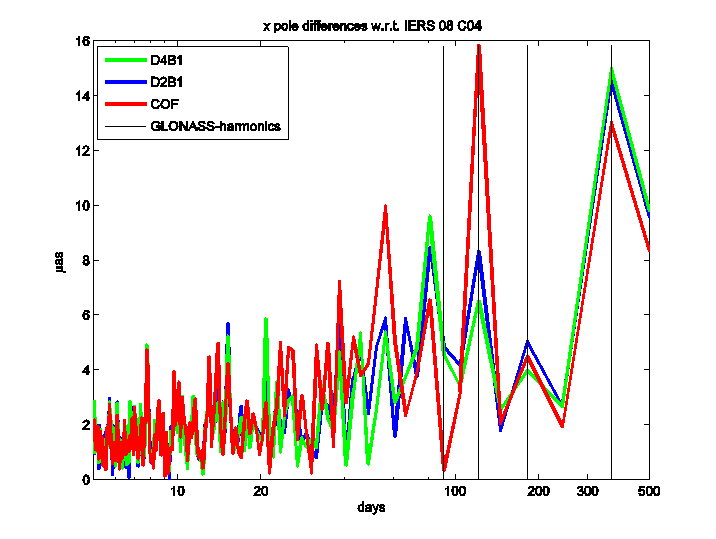Within recent years, deficiencies in geodetically, geodynamically, and geophysically relevant results derived from GPS-only and/or combined GPS/GLONASS solutions were identified in Earth rotation and coordinate time series, e.g., spectral lines with periods clearly due to the time evolution of the GPS or GLONASS constellations. These observations indicate that the satellite orbit models need to be improved. Orbit parameters for the Galileo satellites – where currently the same orbit models as for the GPS and GLONASS satellites are used – show a significant variation with the elevation angle of the Sun above the orbital plane. Such observations clearly indicate that orbit models for all GNSS satellites should be improved.
The 5-parameter Empirical CODE Orbit Model (ECOM) was and is perfectly suited to account for the Solar radiation pressure acting on the GPS satellites. However, Meindl et al. (2013) showed, that the geocenter derived from GLONASS-only solutions for the interval between 2008and2011 had strong spurious, more then 10 cm in amplitude with a frequency of three cycles per year – see also Arnold et al, (2015a). Roriguez-Solano et al. (2014) confirmed that the ECOM was primarily responsible for that problem. This was the motivation for Arnold et al. (2015) to thoroughly analyze the ECOM and developed improved version, which solves for a constant acceleration in each of the three orthogonal directions and, in addition, for even-order periodic accelerations along the D-direction (direction Sun-satellite), and for odd-order accelerations along the B-direction, which is perpendicular to the D-component and the solar panel axis. The revised ECOM is used for all CODE contributions to the IGS since January 4, 2015 (beginning of GPS week 1826).
The GLONASS orbits generated with the old and the new ECOM were validated by Sosnica et al. (2015) using the Satellite Laser Ranging (SLR) observations of the global tracking network of the International Laser Ranging Service (ILRS) for the interval between 2012 and 2013. The SLR residuals of orbits calculated with the old ECOM show a strong systematic behavior as a function of the angle ε between Sun and satellite, as measured from the center of the Earth. No such biases are seen when using the revised ECOM. The figure below illustrates this result: The old ECOM is biased at ε=30° by -50 mm, at ε=180° by +50 mm. This slope virtually disappears for the new ECOM. The color code provides in addition the elevation angle of the Sun above the orbital plane:

At the same time the positive impact of the updated ECOM on geodynamical parameters can be demonstrated:

The figure shows the amplitude spectra of the differences of the x-coordinate of polar motion, as obtained from different orbit models, with respect to the corresponding values of the IERS 08 C04 series, which is in turn based on the contributions of all space geodetic techniques.
The COF series is based the old 5-parameter ECOM, the series D4B1 includes in addition to the parameters of the old ECOM the twice- and four-times-per-rev terms in the D-direction, and D2B1 represents a series, which includes only the twice-per-rev terms in D on top of the classic 5-parameter ECOM. The spurious term at 120 days in the x-coordinate of polar motion is clearly reduced by factors of about 2 and 3 for D2B1 and D4B1, respectively. The analysis performed by Arnold et al (2015a), which led to the definition of the generalized ECOM, was based on the observations analyzed also in the frame of CODE REPRO-2.
References for further readings:
Arnold, D., M. Meindl, G. Beutler, R. Dach, S. Schaer, S. Lutz, L. Prange, K. Sośnica, L. Mervart, A. Jäggi; 2015: CODE's new solar radiation pressure model for GNSS orbit determination. Journal of Geodesy, vol. 89(8), pp. 775-791. DOI 10.1007/s00190-015-0814-4.
Meindl, M., Beutler, G., Thaller, D., Jäggi, A., Dach, R. (2013) Geocenter coordinates estimated from GNSS data as viewed by perturbation theory. Adv. Space Res., 51(7): 1047-1064. DOI 10.1016/j.asr.2012.10.026
Scaramuzza, S., R. Dach, G.Beutler, D. Arnold, A. Jäggi; 2015: Dependency of Geodynamic Parameters on GNSS Constellation. IUGG 2015, Prague, Czech Republic, June 22 - July 2, 2015.